

12AX7 Tube Preamplifier Kit - "Beauty" - Page 2. Page 1: Introduction, Enclosure and ConstructionPage 2: Oscilloscope Measurements, Impressions Oscilloscope Measurements Sine wave response was flat from 25 Hz to 100 kHz (limit of the signal generator I was using).
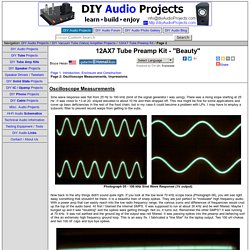
There was a rising slope starting at 25 Hz. It was close to +3 at 20, stayed elevated to about 10 Hz and then dropped off. This rise might be fine for some applications and cover up bass deficiencies in the rest of the food chain, but in my case it could become a problem with LPs. Photograph 05 - 100 kHz Sine Wave Response (1V output) Now back to the why things didn't sound quite right. Hi-Fi Preamplifier (LM358PWRG4)_Circuit Diagram World. This article describes the Hi-Fi Preamplifier (LM358PWRG4).

The content is very simple, very helpful. Components in this article can help you understand better understanding of this article. For example, in this article, you can go to find and buy these components:LM358PWRG4. Please Note: PCBs are available for the latest revision of this project. Click the image for details. Introduction A complete hi-fi preamp including tone controls (and with provision for PCB mounted pots) is something I have avoided, since the pots that are available in different parts of the world are not necessarily compatible. The preamp featured is very straightforward to make on the PCB, and has an innovative tone defeat function. Otherwise, the design is fairly conventional, with the main advantage over other designs being that there are almost no wires to run. Photo of Completed Revision-A Board As you can see, the PCB is very compact. Description Figure 1 – Input and Tone Controls Construction. High Performance Stereo Audio Amplifier using LM3886 - Electronics-Lab.
The LM3886 is a high-performance audio power amplifier capable of delivering 68W of continuous average power to a 4Ω load and 38W into 8Ω with 0.1% THD+N from 20Hz–20kHz.

The performance of the LM3886, utilizing its Self Peak Instantaneous Temperature (°Ke) (SPiKe) protection circuitry, puts it in a class above discrete and hybrid amplifiers by providing an inherently, dynamically protected Safe Operating Area (SOA). SPiKe protection means that these parts are completely safeguarded at the output against overvoltage, under voltage, overloads, including shorts to the supplies, thermal runaway, and instantaneous temperature peaks. The LM3886 maintains an excellent signal-to-noise ratio of greater than 92dB with a typical low noise floor of 2.0µV. It exhibits extremely low THD+N values of 0.03% at the rated output into the rated load over the audio spectrum, and provides excellent linearity with an IMD (SMPTE) typical rating of 0.004%.
50W Power Amplifier with LM3886 - Electronics-Lab. This project is an audio amplifier based on LM3886.

Description This is my second encounter with LM3886. I was pleased of the sound this chip produced the first time, so I decided to make another amplifier with it. TDA7293 Mono Channel Amplifier Board 100W High Power with Rectifier Filter. Siehe Details auf eBay Beobachten Kontakt EUR 9,99 Sofort-Kaufen 1d, Kostenloser Versand, 14 Tage Rücknahmen PicClick Insights PicClick Exklusiv Preis - Popularität - 1.890 Blicke, 33 Beobachtend, Very high amount of views.
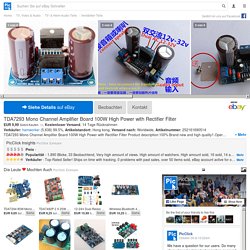
High amount of watchers. High amount sold, 16 sold, 14 available. How can we make PicClick Insights better for you? 1.890 Blicke, 33 Beobachtend, Very high amount of views. LM386 based stereo audio amplifier with digital volume control. Due to its simplicity (requires minimum external components) and high availability, LM386 is very popular among hobbyists for use in low-voltage audio amplification applications.
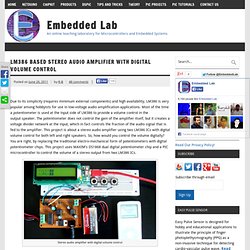
Most of the time a potentiometer is used at the input side of LM386 to provide a volume control in the output speaker. The potentiometer does not control the gain of the amplifier itself, but it creates a voltage divider network at the input, which in fact controls the fraction of the audio signal that is fed to the amplifier. The "Beast" - LM3875 Chip Amplifier (Gainclone) Kit - Audiosector.com. DIY LM3875 Chip Amplifier (Gainclone) Kit The Beast is a LM3875 IC (chip) amplifier, built from a popular chipamp kit.
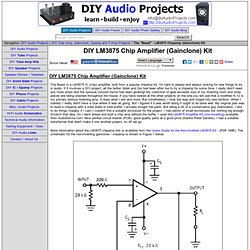
I'm hard to please and always looking for new things to try in audio. If it involves a DIY project, all the better. Mark and Gio had been after me to try a chipamp for some time. I really didn't need any more amps and the spousal concern factor has been growing! DIY LM3886 Chip Amplifier (Gainclone) Kit.
DIY LM3886 Chip Amplifier (Gainclone) Kit So what the heck is a Gainclone?
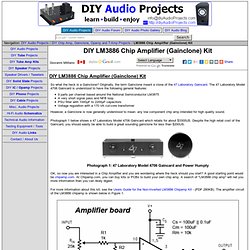
Originally, the term Gainclone meant a clone of the 47 Laboratory Gaincard. The 47 Laboratory Model 4706 Gaincard is understood to have the following general features: 9 parts per channel based around the National Semiconductor LM3875 A very short signal pass and NFB loop PSU filter with 1000µF to 2200µF capacitors Voltage regulation with a 170 VA cut-core transformer However, a Gainclone is now generally understood to mean: any low component chip amp intended for high quality sound. Photograph 1 below shows a 47 Laboratory Model 4706 Gaincard which retails for about $3300US.
Photograph 1: 47 Laboratory Model 4706 Gaincard and Power Humpty OK, so now you are interested in a Chip Amplifier and you are wondering where the heck should you start? Www.ti.com/lit/ds/symlink/lm3886.pdf. LM3886 68W Amplfier. LM3886 68W amplfier: Description: The LM3886 is one of the most popular gainclone chip amps. It features high power (68WRMS, 135W peak) into a 4-ohm speaker, mute, and simple circuitry, making it an excellent choice for the beginner and professional alike. I would like to thank bigparsnip from the DIYAudio Forums for designing this PCB and schematic and allowing it to be posted on electroNET.
LM3875 Gainclone Amplifier.